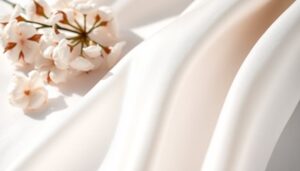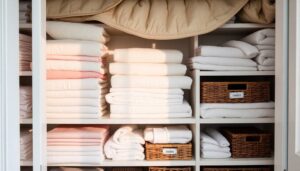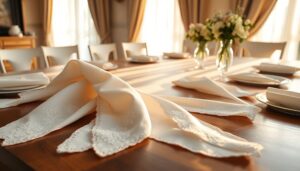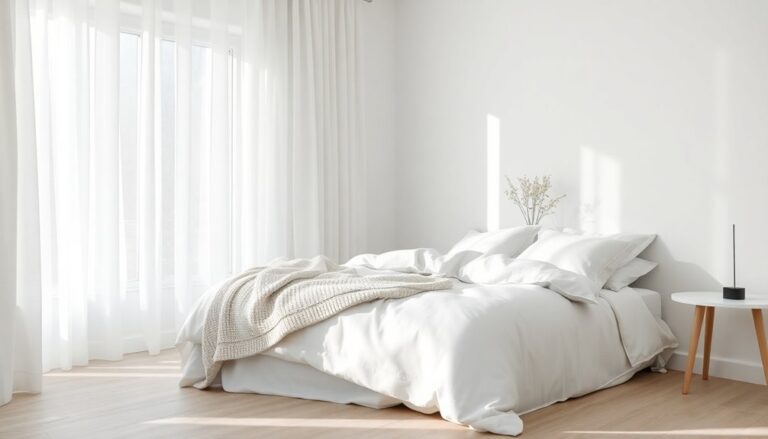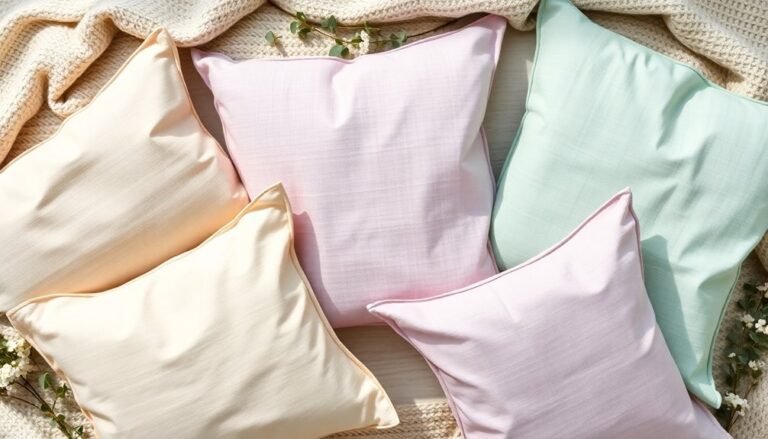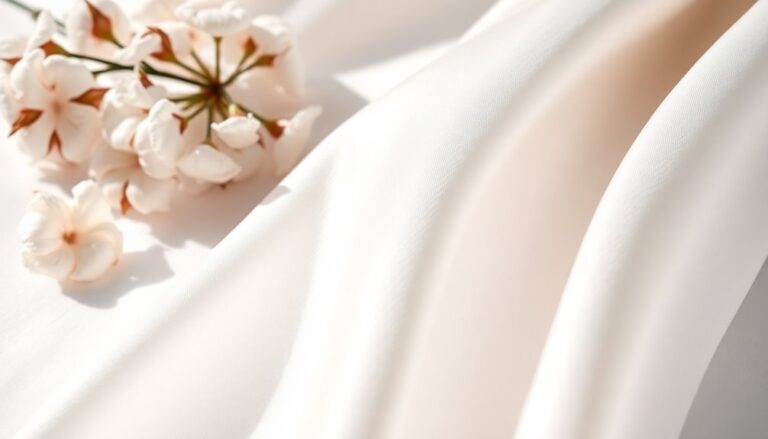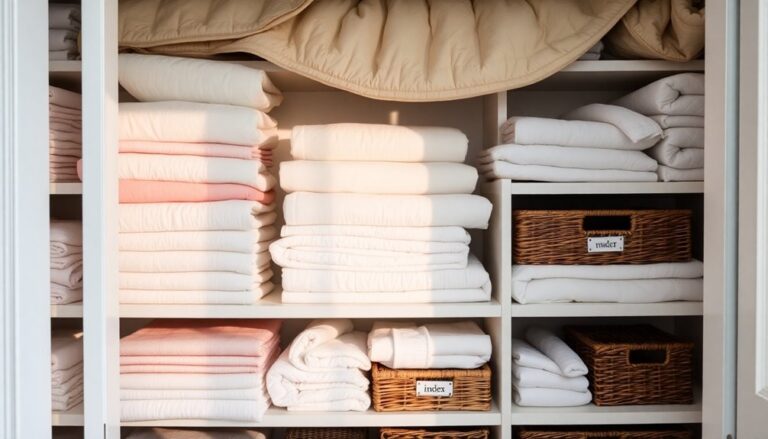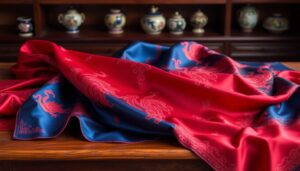Linen and muslin are two distinct fabrics with unique qualities. Linen is a durable, breathable fabric made from the flax plant, known for its strong fibers and slight sheen. It’s often used for structured clothing and home textiles. Muslin, in contrast, is a lightweight cotton fabric that’s versatile and soft, ideal for draping and mock-ups in sewing. Each fabric serves different purposes, and choosing the right one depends on the project at hand. Discover more about their features to help with your choices. When considering a linen vs muslin comparison, it’s important to evaluate factors like texture, durability, and intended use. Linen’s sturdiness makes it ideal for long-lasting garments and home decor, while muslin’s softness and flexibility are perfect for test fittings and lightweight apparel. Understanding their differences ensures you select the best fabric for your needs.
Article Highlights
- Linen is made from flax plant fibers, while muslin is primarily made from cotton, though variations exist.
- Linen is known for its durability and strength, whereas muslin is lightweight and versatile for various applications.
- Linen has a slightly coarse texture that softens over time, while muslin is softer and smoother, ideal for draping.
- Linen requires more careful washing to maintain its quality, while muslin is easy to care for and machine washable.
- Linen is suitable for structured designs and upholstery, while muslin is commonly used for mock-ups and light garments.
Overview of Linen
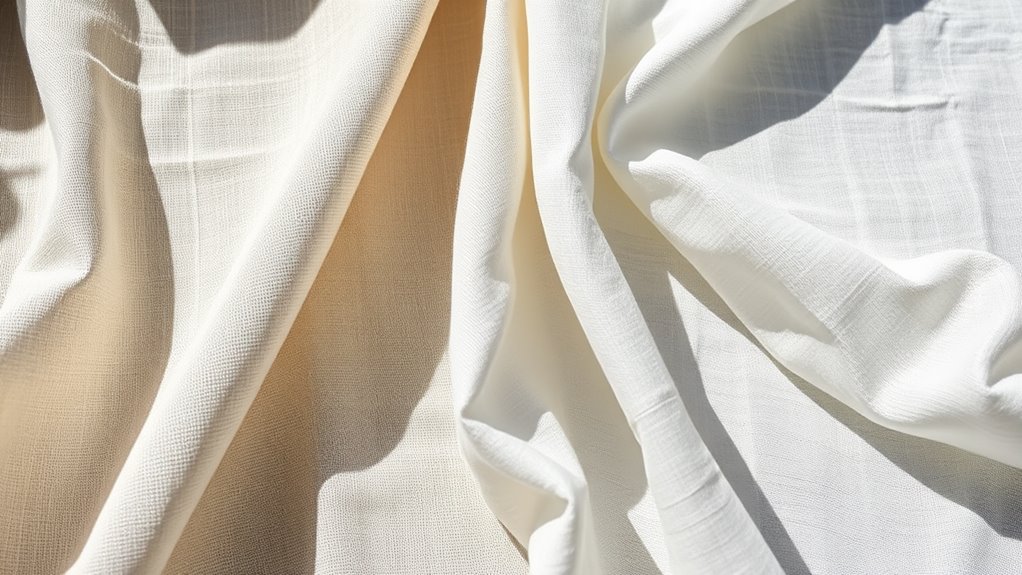
Linen, a timeless fabric renowned for its durability and breathability, has been cherished for centuries. The history of linen dates back to ancient Egypt, where it was used for clothing, burial shrouds, and even currency. Its production involves extracting fibers from the flax plant, a process that requires skill and patience. Traditionally, linen production included harvesting, retting, and spinning, resulting in a fabric that's not just strong but also possesses a unique texture. Over the years, this fabric has evolved, with modern techniques enhancing its quality while maintaining its natural properties. Today, linen remains a popular choice for clothing and home textiles, appealing to those who appreciate its rich history and sustainable nature.
Overview of Muslin
Muslin is a lightweight, versatile fabric known for its softness and breathability. It's primarily made from cotton, though silk and hemp variations exist. There are several muslin types, including plain muslin, double-gauze, and bleached muslin, each with different textures and uses. Muslin's affordability and adaptability make it popular for various applications. It's commonly used in sewing, particularly for making toiles or mock-ups of garments, allowing designers to test patterns before committing to more expensive fabrics. Furthermore, muslin serves as a backdrop in photography, a protective covering for delicate items, and even in culinary settings for straining liquids. Its numerous uses highlight muslin's practicality in both creative and functional domains.
Key Characteristics of Linen
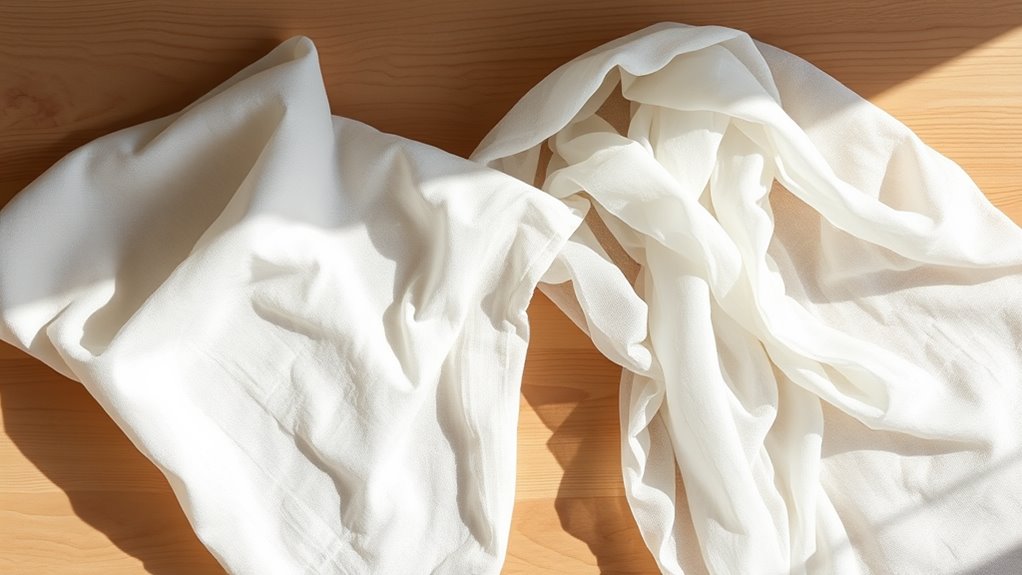
Renowned for its durability and natural luster, linen is a fabric that stands out in the textile world. This remarkable material is celebrated for its exceptional linen durability, making it ideal for various applications, from clothing to home textiles. Linen's breathability allows for comfortable wear in warm weather, as it absorbs moisture efficiently and dries quickly.
Here's a quick overview of linen's key characteristics:
| Property | Description | Benefits |
|---|---|---|
| Durability | Strong, long-lasting fibers | Resists wear and tear |
| Breathability | Highly porous fabric | Keeps the body cool |
| Texture | Slightly coarse yet soft | Provides a unique feel |
| Maintenance | Requires careful washing | Retains shape and quality |
| Appearance | Natural sheen, becomes softer over time | Improves aesthetic appeal |
Key Characteristics of Muslin
Even though linen is celebrated for its strength and breathability, muslin offers its own unique advantages that make it a versatile choice in the textile domain. Known for its lightweight texture and softness, muslin is often used in various applications, including clothing, curtains, and crafting. Its affordability and ease of use make it popular among both beginners and experts alike.
- Ideal for draping and pattern-making in fashion design
- Suitable for infants' clothing because of its gentle feel
- Easily customizable with dyes and prints for creative projects
When it comes to muslin maintenance, it's relatively simple, as it can be machine washed and dried, retaining its quality over time. This makes muslin a practical option for many households.
Choosing the Right Fabric for Your Project

How does one select the right fabric for their project? Comprehending fabric weight and project purpose is key. Choosing between linen and muslin can greatly impact the outcome. For lightweight projects, muslin's breathability is ideal, whereas linen suits heavier, structured designs. Here's a quick comparison to guide decisions:
| Fabric Type | Weight | Best For |
|---|---|---|
| Linen | Medium-Heavy | Clothing, upholstery |
| Muslin | Lightweight | Draping, patterns |
| Linen Blend | Varies | Versatile applications |
| Organic Muslin | Lightweight | Eco-friendly garments |
| Cotton Muslin | Lightweight | Crafts, quilting |
Frequently Asked Questions
Can Linen and Muslin Be Blended With Other Fabrics?
When considering fabric blends, it's crucial to recognize that both linen and muslin can certainly be combined with other textiles. Blending these fabrics with materials like cotton or polyester can improve their textile properties, resulting in a more versatile fabric. For instance, a linen-cotton blend retains the breathability of linen as it adds softness and durability from cotton. This versatility makes blended fabrics suitable for various applications, from clothing to home décor.
How Do I Care for Linen and Muslin Fabrics?
Caring for linen and muslin fabrics is like tending to delicate flowers in a garden. For fabric maintenance, gentle washing techniques are crucial. It's best to use cold water and a mild detergent to preserve their texture and color. Avoid bleach, as it can be harsh. Air drying is recommended, but if using a dryer, opt for a low heat setting. With these steps, they'll remain beautiful and last longer.
Are There Any Eco-Friendly Options for Linen and Muslin?
When considering eco-friendly options for fabric, it's important to explore sustainable sourcing. Many brands now offer organic options for both linen and muslin, which minimize environmental impact. These fabrics are often made from fibers sourced without harmful chemicals, promoting healthier ecosystems. Consumers looking for eco-conscious choices can easily find these alternatives, ensuring they're making responsible decisions whilst enjoying quality textiles that align with their values.
What Are the Historical Uses of Linen and Muslin?
Throughout history, linen and muslin have played significant roles in fabric evolution, serving various purposes across cultures. Linen, prized for its durability, was commonly used in ancient Egypt for garments and burial shrouds, symbolizing status. Muslin, originating in South Asia, became crucial for lightweight clothing and household textiles. Both fabrics reflect their historical significance, influencing fashion and economy, proving their enduring appeal and adaptability in different contexts over the centuries.
Which Fabric Is More Suitable for Summer Clothing?
When considering which fabric's more suitable for summer clothing, it's crucial to look at breathability comparison and moisture absorption. Linen's known for its excellent breathability, allowing air to flow freely, which keeps wearers cool. Muslin, in addition, breathable, tends to absorb moisture less efficiently. Consequently, for hot weather, many prefer linen as it wicks away sweat effectively, making it the go-to choice for comfortable, stylish summer attire.

